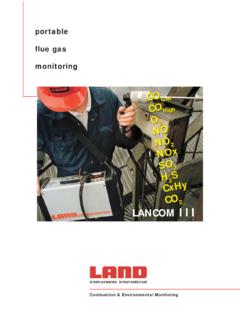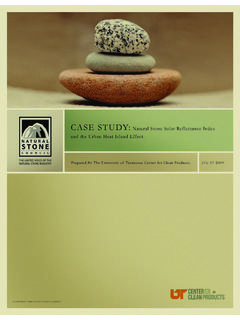Transcription of A basic guide to Thermography - L-IR Korea
1 A basic guide to Thermography Land Instruments International Infrared Temperature Measurement Dronfield S18 1DJ England Telephone: (01246) 417691 Facsimile: (01246) 410585 Email: Internet: Land Instruments International, 2004 Land Instruments International Infrared Temperature Measurement 10 Friends Lane Newtown, PA 18940-1804 USA Telephone: (215) 504 8000 Facsimile: (215) 504 0879 Email: Internet: Publication No: Training ThermographyV1/1104 1 A basic guide TO Thermography USING THERMAL IMAGERS Thermography Thermography is a method of inspecting electrical and mechanical equipment by obtaining heat distribution pictures. This inspection method is based on the fact that most components in a system show an increase in temperature when malfunctioning. The increase in temperature in an electrical circuit could be due to loose connections or a worn bearing in the case of mechanical equipment.
2 By observing the heat patterns in operational system components, faults can be located and their seriousness evaluated. Fig 1. The Thermal Image of electrical connector The inspection tool used by Thermographers is the Thermal Imager. These are sophisticated devices which measure the natural emissions of infrared radiation from a heated object and produce a thermal picture. Modern Thermal Imagers are portable with easily operated controls. As physical contact with the system is not required, inspections can be made under full operational conditions resulting in no loss of production or downtime. Fig 2. The inspection of electrical equipment using a Thermal Imager The Land Cyclops Thermal Imager is a device designed for plant condition monitoring, preventative maintenance and process monitoring applications. Potential applications include: Inspection of electrical equipment Inspection of mechanical equipment Inspection of refractory lined structures 2 Measurement of Temperature using Infrared Methods When using a Thermal Imager it is helpful to have a basic knowledge of infrared theory.
3 basics Physics An object when heated radiates electromagnetic energy. The amount of energy is related to the object s temperature. The Thermal Imager can determine the temperature of the object without physical contact by measuring the emitted energy. Electromagnetic Spectrum The energy from a heated object is radiated at different levels across the electromagnetic spectrum. In most industrial applications it is the energy radiated at infrared wavelengths which is used to determine the object s temperature. Figure 3 shows various forms of radiated energy in the electromagnetic spectrum including X-rays, Ultra Violet, Infrared and Radio. They are all emitted in the form of a wave and travel at the speed of light. The only difference between them is their wavelength which is related to frequency. Visible Region Fig 3. The Infrared region of the Electromagnetic spectrum The human eye responds to visible light in the range to microns.
4 The vast majority of infrared temperature measurement is made in the range to 20 microns. Although emissions are mostly unable to be detected by a standard camera the Thermal Imager can focus this energy via an optical system on to a detector in a similar way to visible light. The detector converts infrared energy into an electrical voltage which after amplification and complex signal processing is used to build the thermal picture in the operator s viewfinder on board the Thermal Imager. 3 Energy Distribution Figure 4 shows the energy emitted by a target at different temperatures. As can be seen the higher the target temperature the higher the peak energy level. The wavelength at which peak energy occurs becomes progressively shorter as temperature increases. At low temperatures the bulk of the energy is at long wavelengths. Visible region Fig 4. Infrared energy and distribution across the Electromagnetic spectrum Emissivity The amount of energy radiated from an object is dependant on its temperature and its emissivity.
5 An object which has the ability to radiate the maximum possible energy for its temperature is known as a Black Body. In practice there are no perfect emitters and surfaces tend to radiate somewhat less energy than a Black Body. Fig 5. The Infrared energy reflected at a body surface Figure 5 shows why objects are not perfect emitters of infrared energy. As energy moves towards the surface a certain amount is reflected back inside and never escapes by radiative means. From this example it can be seen that only 60% of the available energy is actually emitted. The emissivity of an object is the ratio of the energy radiated to that which the object would emit if it were a Black Body. 4 Hence emissivity is expressed as:- Emissivity = Radiation emitted by an object at temperature T Radiation emitted by a Black Body at temperature T Emissivity is therefore an expression of an object s ability to radiate Infrared energy.
6 Emissivity values The value of emissivity tends to vary from one material to another. With metals a rough or oxidised surface usually has a higher emissivity than a polished surface. Here are some examples: Material Emissivity Steel polished Steel oxidised Brass polished Brass oxidised Aluminium polished Aluminium oxidised Cement and Concrete Asphalt Red Brick Graphite Cloth Emissivity values (TI814 only) It can be shown that there is a relationship between emissivity and reflectivity. For an opaque object this is Emissivity + Reflectivity = Hence a highly reflective material is a poor emitter of infrared energy and will therefore have a low emissivity value. Effects of Emissivity If a material of high emissivity and one of low emissivity were placed side by side inside a furnace and heated to exactly the same temperature, the material with low emissivity would appear to the eye much duller. This is due to the different emissivities of the materials causing them to radiate at different levels, making the low emissivity material appear cooler than the high emissivity material, even though they are at exactly the same temperature.
7 The Thermal Imager would see this in the same way as the eye and produce an error in making the temperature measurement. The temperature of an object cannot be determined by simply measuring its emitted infrared energy, a knowledge of the object s emissivity must also be known. 5 The emissivity of an object can be determined as follows: 1) Consult manufacturers literature (always ensure these have been evaluated at the operating wavelength of your Thermal Imager as emissivity can vary with wavelength). 2) Have the object s emissivity evaluated by a laboratory method. There are two main ways to overcome the problem of emissivity. a) Mathematically correct the temperature measurement value. This is usually carried out within the signal processor of the Thermal Imager. Most modern Thermal Imagers have a compensation setting which can quickly and easily be set by the operator. b) It may be possible to paint the surface of a low emissivity target with a high and constant emissivity coating.
8 This tends to elevate the target to a much higher emissivity level, but this may not be possible on all process plants. When carrying out Thermographic inspections, faults are often identified by comparing heat patterns in similar components operating under similar loads. This is an alternative to very precisely predicting the emissivity of each individual component and obtaining absolute temperature values. Thermal Imager being used to inspect electrical equipment. With equal load and emissivities the temperature of the three measurement points should be the same. 6 Thermal Imagers Thermal Imagers are sophisticated devices which measure the natural emissions of infrared radiation from a heated object and produce a thermal picture. Modern Thermal imagers such as the Land TI814 are usually very flexible containing many standard and optional features. Here are some of those of the TI814. Optical: A motorised focus is used to obtain a clear image at different distances from the thermal imager.
9 The focus distance is from 380mm / 15 inches to infinity. An electronic zoom function enables 2X and 4X magnification of the image. Image Display: The real time thermal image is displayed in colour on a 102mm / 4 inch LCD screen. The image may be colourised by any one of the eight different palettes available. The real time thermal image is also displayed on the built-in high resolution colour viewfinder. Digital Memory: A built in non volatile memory system enables the simple capture of a large number of thermal images. Thermal images are stored on a removable compact flash memory card. This on board facility enables stored image recall to the viewfinder and selective image deletion. Several seconds of digital voice clip may be stored with each image and replayed or re-recorded on board the imager. The sound file can be replayed in by the imager or with image processing software. A 256MB card is capable of storing up to 1000 thermal images and up to an eight second digital voice clip with each image.
10 Image file size including voice annotation is 256 KB. Transfer to image processing software for further image processing and report generation is via a USB Compact Flash memory card reader. Temperature Measurement: Temperature measurement at single point in the scene is possible. Post Processing: This facility enables the generation of further temperature analysis in the imager viewfinder on stored images. A single movable point enables spot measurement at any point in the scene and a movable cursor generates a temperature profile trace. Image Processing Software Frames of interest may be stored as an image file for record purposes, or be subjected to a range of processing functions as follows: a) File handling: save, delete and directory facility b) Image colouring: the image may be colourised using any one of five colour palettes. c) Temperature measurement: a variety of different modes are available to enable temperature measurement at any point in the scene, calculation of maximum, minimum or mean from within any defined area in the scene, profiles, histograms, and isotherms.




![SFPE Equation Sheet [KL 10-19-2015]](/cache/preview/c/f/3/c/2/1/e/4/thumb-cf3c21e48064d8fdafc6507dedc08886.jpg)


